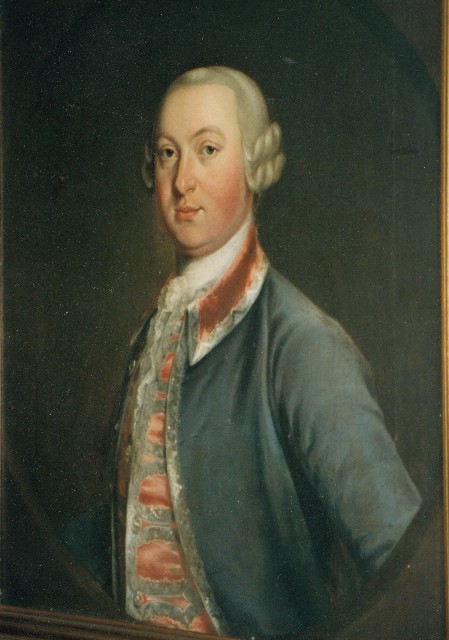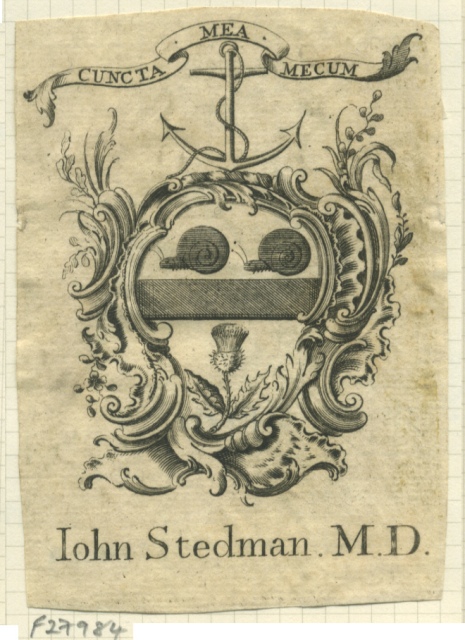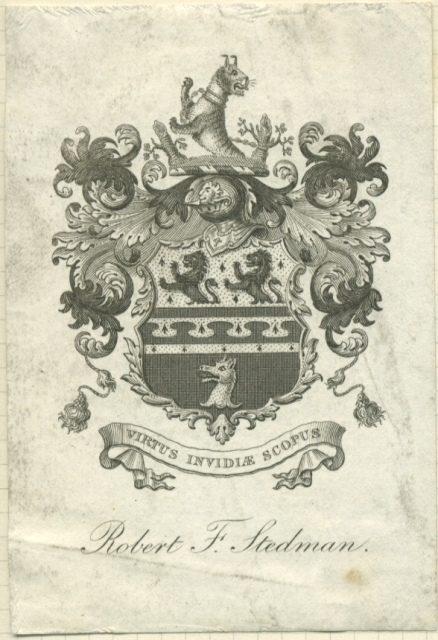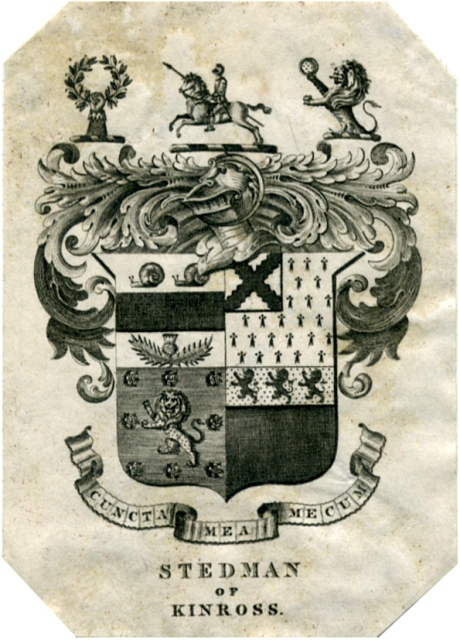Stedman Family Crests. Which Stedman is your family?
You searched for 'Stedman', but there are 10 families with that name in our historic records. Do you know where your family came from, recognise the name of an ancestor or see your crest? If so, please click on your family from the list below..
SELECT YOUR CREST TO SEE AVAILABLE SILVER
AND REGISTER FOR SALE ALERTS
Stedman
Stedman/Steadman/Steedman
Family history
In Joseph Earle Steadman’s 1987 “Barton and Stedman; also Steedman and Steadman” he traces the origins of the Stedman’s back to Calcarba (or Galiardus) de Steddenham, an Arabian Nobleman, who arrived in England circa 1146 and accompanied King Richard, Coeur de Lion, back to the Holy Land where he took part in the siege of “Aron”. However I am not sure there was a siege of Aron and wonder whether they meant Acre. It is worth noting that since the crusades many families have claimed erroneously that a family member took part. Without corroboration from contemporary chroniclers any such claims must be treated with caution.
Mr Steadman records that Calcarba’s son John le Stedeman was knighted in the crusades and was imprisoned with King Richard. He was awarded a manor in Kent and married Margaret Tatsall, daughter of Richard Tatsall, brother of Robert Lord Tatsall and had four sons.
It is believed that it is from these four sons that all the Stedman’s descend.
Until the mid 19th century when spellings were standardised the name was spelt as it sounded and so several variations arose, such as Steadman, Steidman and Steedman.
Hugh le Stedeman went to Sussex; John le Stedeman went to Staffordshire and was the ancestor of the Shropshire and Scottish branches of the family; and Richard went to Wales and was the ancestor of the welsh branch. In most cases they swelled the ranks of the minor gentry.
In time each branch adopted different arms and Burkes General Armory (1884) records 3 separate arms for Steadman and 4 for Stedman.
Steadman. Argent, a chevron gules between 3 boars heads couped sable. Crest: A demi griffin or.
Steadman (Scotland 16th century): Argent a fess vert between 3 snails azure
Steadman (Scotland, 16t century): Argent two snails in chief azure in and in the base a bunch of 3 holly leaves vert.
Stedman. (co. Gloucester). Or on a cross crosslet vert. Crest: a demi virgin proper, hair dishevelled, holding in the dexter hand a cross crosslet vert.
Stedman. (Dolgoer, Brecknock). Chequy or and gules, a chief ermine.
Stedman. (co. Salop) Argent a chevron gules between 3 boars heads couped (another erased) sable. Crest: a peacocks head between two wings and and holding in the beak an adder proper.
Stedman. Vert a fess argent between two pheons in chief and an anchor in base or. Crest: An anchor proper.
There is some commonality between some of these arms and it is clear that the Scottish Stedmans were at times called Steadman.
The Scottish Stedman’s
John le Stedeman of Staffordshire in turn had several sons and over the succeeding generations they spread over many of the Northern counties; their names cropping up regularly in the court reports and records of disputes over land holdings.
The branch that was settled in Yorkshire gave assistance to the scots in their regular raids on the north. Joseph Steadman cites records showing that “Thomas le Stedeman of the West Riding of County York, son of John le Stedeman of Fulford, in 1299 was named in a “commission (or writ) of oyer and terminer” granted to a certain person for hearing and determining a case against him. Since the case involved treason, felony, or misdemeanor on the part of Thomas, and since the act was committed during the period of strife between Edward I (King of England) and Robert Bruce (crowned King of Scotland in 1306), it appears that the criminal act was related to the political struggle of the time. He probably was charged with having given aid and encouragement to the Scots, but eventually escaped and fled to Scotland where he became a supporter of the cause of independence for that country.”
“Simon le Stedman presumably was born in County York, England, and went to Scotland with his father. He evidently was a leader among the Scots’ forces sent by Robert Bruce (King of Scotland) to harry the English Counties of York and Northumberland, in retaliation for English inroads in Scotland, during the period of 1318-1323. In 1321 he was in an engagement with a body of Englishmen commanded by Sir Alexander de Mowbray. This engagement resulted in a peace treaty between Simon le Stedeman, Scotsman, and Sir Alexander de Mowbray, as recorded in the Records of the Scottish Privy Council. Another record states that in 1321 Simon le Stedeman was received to the English King’s (Edward II’s) peace,” evidently meaning that the king received and agreed to the peace treaty made between Stedeman and Mowbray. (Black, The Surnames of Scotland.)”
By the middle of the 14th century Patricus Stedeman is recorded as owning property in Leith and is given as the ancestor of Charles Stedman, a prosperous merchant operating in Edinburgh and Leith.
Charles Stedman’s daughter, Susan, by his wife, Janet Neilson of Leith married Charles Barton, son of the celebrated Scottish Admiral, Sir Andrew Barton. Upon marriage Charles Barton petitioned to Queen Mary of Scotland to adopt the name and arms of his father in law. The full family history from this point is laid out in “The Scottish Nation” (1863) by William Anderson, pp. 507-508.
“STEDMAN, a surname adopted by Charles Barton, son of the celebrated Scottish admiral, Sir Andrew Barton. Charles Barton married Susan, daughter of Charles Stedman and his wife Janet Neilson of Leith. Susan was possessed of considerable property, and Charles, on his marriage, took the name of his wife, and his descendants continued it. He had several children. His eldest son, Alexander, died in 1593.
Alexander's son, William, married Margaret Anderson, and died in 1606, leaving a son, Alexander Stedman, Kinross. The son of the latter, Robert Stedman, of the Milne Lead and Gala Hill, Kinross, and of Little Seggie and Ballingall, Kinross-shire, married Agnes, daughter of Michael Henderson of Turfhills, in the same county.
Robert left three sons.
1. James, the eldest, succeeded to the lands of Little Seggie, which became the designation of his family. He was also seized in the lands of Milnathort, Kinross-shire, in 1648. Born in 1598, he died in 1686. He married Euphan, daughter of James Dempster of Tillyochie, Kinross-shire.
2. John. He succeeded to his father's property in lands and houses in Kinross. He married Jean Dempster of Tillyochie, and died in 1673.
3. Robert. He succeeded to the lands of Ballingall, which became the designation of his family. He was twice married, and left issue.
James Stedman of Little Seggie, the eldest son, had a son, the Rev. Robert Stedman, for 52 years minister of Carriden, Linlithgowshire. In the old churchyard of the parish there is a monument to his memory, erected by his relict, Sarah, daughter of Sir Alexander Ingles of Inglistown, in that county. He joined the protesting party in the Church of Scotland, and was deposed in 1661. Subsequently he was restored, and was the first moderator of the presbytery of Linlithgow, Nov. 30, 1687. Born in 1625, he died in 1701. He left four sons, Alexander, James, Robert, and John.
1. Alexander, ordained minister of Beith, Fifeshire, in 1691, succeeded his father in Little Seggie.
2. James, born in 1662, married Janet Bairdie, Linlithgow. He predeceased his father, without male issue. At the base of the public fountain in Linlithgow, there was, in 1843, a large tombstone of Dutch marble (removed from the burial-ground of Linlithgow Cathedral), with the remains of an inscription, "Here lyes the Body of Janet Bairdie, spows of Stedman," and the figures 67, supposed to be her age.
3. Robert, born in 1667, like his ancestors, the Bartons, seems early to have been prepossessed in favour of a maritime life. He became the owner and commander of a ship which traded between Borrowstowness and Holland. He extended his voyages to Denmark, Norway, and Sweden, and, in course of time, became possessed of no fewer than 13 ships. He amassed considerable wealth, which he ultimately lost. He died in 1738. By his wife, Margaret, daughter of Edward Jossey of West Pans, East Lothian, he had several sons. Edward, the eldest, born in 1699, was minister of Haddington, and died in 1756. Alexander, the 3d son, born in 1703, and educated for the Scottish bar, was distinguished as a sound lawyer and profound mathematician. He joined the Pretender in 1745, and, with his brothers, John and Charles, was taken prisoner at Culloden. They all effected their escape, Alexander and Charles to America, and John to Rotterdam. Alexander settled in Philadelphia, where he practiced his profession with great success, and having made his peace with the mother country, was appointed a judge of the supreme court of Pennsylvania, March 19, 1764. On the declaration of Independence of the American Colonies, he returned to Scotland, and subsequently went to Swansea, in Wales, where he died at the advanced age of 91. His son, Charles Stedman, born in 1753, on the revolt of the American colonies, joined the British forces, and was placed at the head of the commissariat department. Soon after the battle of Brooklyn in 1776, he was made prisoner, and carried to New York. The rapid advance of the British army caused the Americans to abandon that city in haste, and he was released. In 1780 he was again taken prisoner, while commanding a foraging party in the vicinity of Springfield, Burlington, New Jersey, but made his escape. He was appointed aide-de-camp to Baron Linsingen, then in command of the auxiliary Hessian troops, retaining his commissary powers. Owing to the scarcity of provisions, a rifle corps of German emigrants was raised, to the number of 400, and, being placed under his command, proved an efficient foraging force. At the battle of Guildford Court-house, March 15, 1781, he was wounded in his sword hand, in single combat with an American dragoon, and was only saved from being cut down, by the appearance of a British light horseman, who slew his adversary. At the peace of 1783, he came to England, and retired on the half-pay of a colonel. He was the author of a 'History of the American War,' published in 1794. In 1797, through the influence of the Marquis Cornwallis, he was appointed deputy-comptroller and accountant-general of the revenue of stamps, an office created on the occasion. He died in 1812, and was succeeded in his office by his only son John, born in 1786. In 1813 the latter was appointed civil secretary at Gibraltar and registrar of the Supreme Court of Appeal, and in 1816 one of the judges of the Court of Admiralty there.
4. John Stedman of Wester Baldridge, Fifeshire. Born in 1678, he was ordained, in 1699, minister of Dalmeny, Linlithgowshire, and, in 1710, translated to the Tron church, Edinburgh. He died in 1713. By his wife, Jean, 2d daughter of Rev. John Kinniard, minister of East Calder, he had three sons; Robert, Alexander, and John, and six daughters.
Robert Stedman, the eldest son, born in 1701, entered in 1730, as ensign in the Scots brigade in the Dutch service, and rose to the rank of lieutenant-colonel. He was at the battles of Fontenoy and Rocroix, and the sieges of Dendermond and Bergen-op Zoom, and died at Breda in 1770. He left two sons, John Gabriel, born 1741, and William George, born 1748, both lieutenant-colonels in the Scots brigade, Dutch service. John Gabriel, the elder son, was infeft in Ernieside, Kinross-shire, in 1791. In 1796 he published a 'Narrative of a Five Years' Expedition against the revolted Negroes of Surinam from 1772 to 1777.' The same year he was appointed to the command of a British regiment of the line, then in garrison at Gibraltar, but was prevented by an accident from joining it, and died in 1797.
Alexander, the 2d son, died at Jamaica, unmarried.
John, the 3d son, born in 1710, was, in 1740, appointed surgeon to the North British dragoons, or Scots Greys. He afterwards practiced as a physician in Dunfermline, and subsequently settled in Edinburgh. Besides several medical treatises, he was the author of 'Laelius and Hortensia, or thoughts on the Nature and Objects of Taste and Genius.' He succeeded to Little Seggie in 1765, and married Peggy, daughter of Robert Wellwood of Pitliver, Perthshire. He died in 1791. [His second daughter, Jean, married Capt John Christie, brother of Admiral Alex. Christie of Baberton, Mid Lothian and the author descends from their son John Stedman Christie by his wife ,Marianne, grand-daughter of William Morehead of Herbertshire, who was, like Dr Stedman, a founding member of the Royal Society if Edinburgh.]

The portrait of John Stedman MD courtesy and copyright a private family collection.
Lieutenant-colonel John Gabriel Stedman of Ernieside had 3 sons. 1. William George, born 1784, who succeeded him in that property. He was a lieutenant in the royal navy, and was killed while boarding a French privateer of the island of Cuba. 2. Robert Adrian, born in 1790, lieutenant-colonel 1st light cavalry, in the East India Company's service, and C.B. He succeeded his brother in Ernieside in 1812. He was at the battle of Aliwal in the Punjaub, Jan. 28, 1846, and was mentioned with high praise in the dispatch of Sir Harry Smith, the commander-in-chief. He died at sea, April 12, 1849, on his voyage home, after having served 41 years in India. A monument to his memory is erected at Cawnpore by his brother officers. 3. John Cambridge, born in 1796, a captain 34th light infantry, East India Company's service, was killed in 1834 in battle in Burmah.
Lieutenant-colonel William George Stedman had an only son, Lieutenant-general John Andrew Stedman, born in 1788, who entered the Dutch service as a cadet, and rose to the rank of lieutenant-general. On 17th and 18th June, 1815, he covered with the Dutch troops the right wing of the allied army, and the road from Mons to Brussels, under the command of the Duke of Wellington. He received several orders of knighthood, and was made by Louis XVIII., an officer of the Legion of Honour. He died in 1824. His only son, Charles John #William, became a naturalized subject of Prussia, and Baron de Stedman in that kingdom.”
However it appears that Charles Barton did something unusual when he adopted his wife’s arms. Normally an heraldic heiresses arms are shown on an escutcheon on her husbands arms but in this instance he appears to have genuinely merged them.
The 19th century genealogist Charles von Barton-Stedman noted that the resulting Stedman arms are exhibited in the oldest registers of the Lord Lyon's Office, Edinburgh, as in the system of Heraldry, edited 1704, by Alexander Nisbet, under the patronage of the last Scottish Parliament.
Joseph Steadman notes that: “As for the arms, it is supposed that the family of Barton is the same as exists in Normandy, where they bear gules (red shield) with annulets or (gold) on it. The Yorkshire Bartons came to Scotland after a contest with Edward III.; and in 1511 Sir Andrew Barton is found bearing gules, three house-snails, or, the house-snails having probably arisen from the annulets being sometimes represented merely as rolled shells, without the animals issuing from them. They are erect in the books of the Lord Lyon, and creeping, as seen on the seal and monument of Rev. Robert Stedman, minister of Carriden, Co. Linlithgow, who obit there 1701. His monument, with his arms carved in stone, was erected by his widow, Sarah, daur. of Sir Alexander Inglis of Inglis Town, Co. Linlithgow, Knt. She ob. 1720.
To the latter belongs the motto, "Cuncta mea caecum."
"There is no legal authority," Von Barton thinks, "for the motto," and he suspects it to be "a corruption for 'cunctare mecum ' (delay with me), as the heraldic meaning of snails is notoriously delaying; neither having the beggars' practice of carrying all their luggage on their back, nor the satirical allusion of the Netherland guesses with their 'Besace,' arisen 1566."
"About the same year Charles de Barton," he adds, "married Susan Stedman, Edinburgh ; and as she appears to have been an heiress, Charles took her name, whilst his own fell into oblivion, for some good reason, I believe, as the English destroyed the house of John de Barton at Leith. The Stedmans must have borne a coat-of-arms, argent, three leaves of sea-holly thistle, conjoined proper (green). Charles blended both the shields, and bore argent two house-snails, purpure in chief and three leaves of sea-holly thistle in base. Other Stedmans kept the three snails azure, on a field argent, and a fesse vert for their difference." The writer further says, that "he would be very happy to know exactly to what persons, about anno 1600 (Tim. Pont) and 1704 (Alex. Nisbet), these arms belonged"
Anthony Pincott of the Bookplate Society (www.bookplatesociety.org) has kindly provided copies of some Stedman bookplates and they are shown below:

The bookplate above for Dr Stedman illustrates the arms granted to Charles Barton when he changed his name to Stedman. Although the holly leaves appear to have become a thistle. The anchor crest presumably representing the both the Barton and Stedman familes interests in the sea, shipping and the port of Leith.


SNBM